If you plan on traveling with your Fujifilm mirrorless camera, you should make sure you have a lens that allows you to photograph everything you encounter.
Most people buy a zoom with plenty of reach, a couple of prime lenses, or a combination of both. It all depends on how you want to travel.
In this guide, we went through all Fujifilm’s lenses to pick out the travel options, whether you’re a professional or a beginner. We made sure to focus on image quality, versatility and how much you get for the price.
Best Fujifilm Zoom Travel Lenses:
Fujifilm XF 10-24mm f/4 R OIS
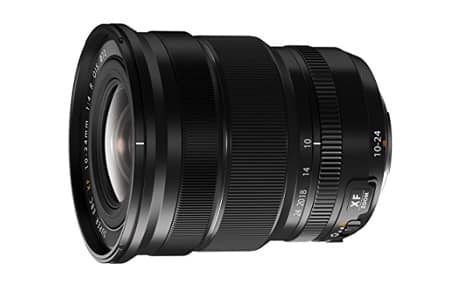 Fujifilm XF 18-55mm f/2.8-4 R LM OIS
Fujifilm XF 18-55mm f/2.8-4 R LM OIS
Fujifilm XF 18-135mm f/3.5-5.6 R LM OIS WR
Fujifilm XF 55-200mm f/3.5-4.8 R LM OIS
Best Fujifilm Prime Travel Lenses:
Fujifilm XF 23mm f/1.4 R
Fujifilm XF 23mm f/2 R WR
Fujifilm XF 27mm f/2.8
Fujifilm XF 35mm f/2 R WR
Fujifilm XF 50mm f/2 R WR
We discuss all of these lenses below, but first let’s go through what matters when buying a lens for traveling.
If you decide to buy anything after clicking on our Amazon links, you automatically support us. It’s what allows us to write guides such as this one.
What’s Important for Travel Photography?
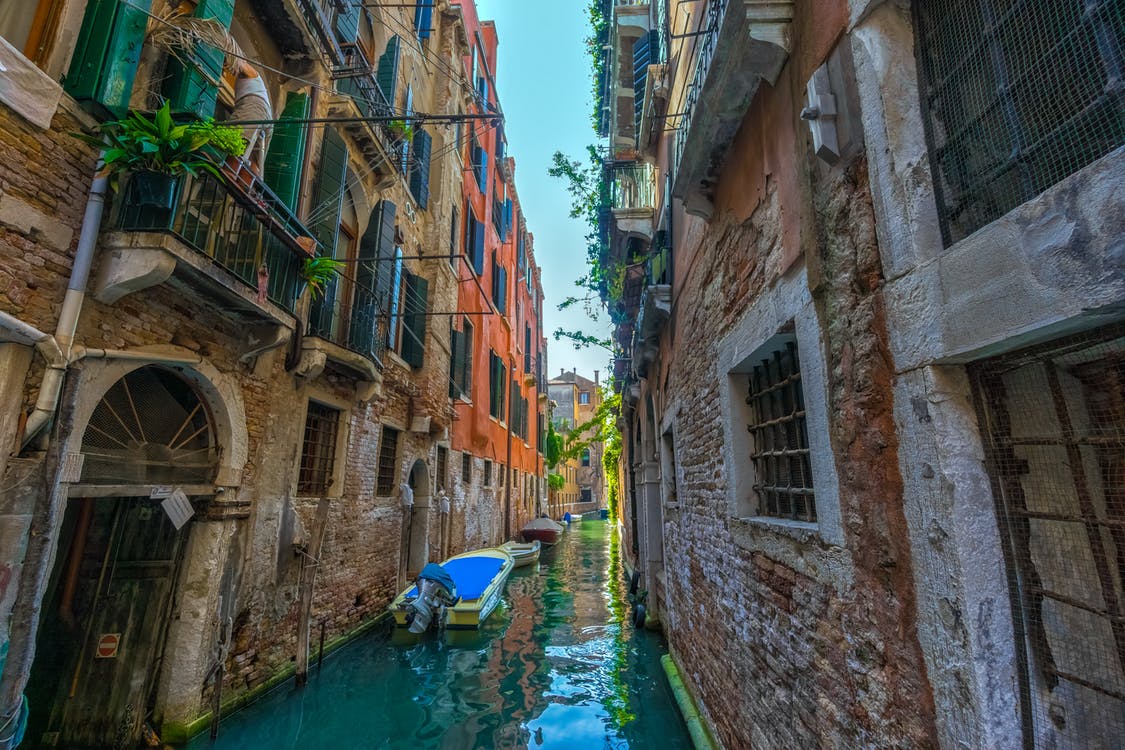
Here are the 6 most important factors that make a good travel lens.
Focal Length – Traveling is a very broad term, so you want to be fully prepared. A zoom lens with plenty of reach is an excellent way to go if you want to keep it simple, and be re ready to photograph anything from landscape, nature, to portraits and interiors. Many photographers also use prime lenses, but rarely above 50mm. Fuji has plenty of good wide angle options, and we recommend you to stick between 14mm and 50mm, depending on what you prefer to take pictures of. A combination of both, a good zoom and a high quality prime for low light, is also fantastic.
Aperture – The bigger the aperture, the bigger the lens, especially if it’s a zoom. For this reason, we didn’t include Fuji’s 55-140mm because it is most likely too heavy/big for you to consider it a travel choice. Prime lenses on the other hand, can go up to f/2 and still be extremely compact. A big aperture will allow you to shoot in low light and indoors and get reasonably fast shutter speeds. For portraits, it also makes your background appear nicely blurred. For outdoor photography, smaller apertures are normal and you’ll be perfectly fine with zoom lenses that are at f/4 or even f/5.6.
Auto Focus – Good, reliable and accurate auto focus is a must. When traveling, you don’t always have the time to do it manually or take a few different shots. Thankfully, Fujifilm’s cameras and lenses all focus very quickly.
Weight & Size – Photographing is fun, carrying a ton of heavy gear is not. Make sure to look at how big and heavy a lens is, especially if you always travel with lots of other stuff as well. While Fujifilm’s mirrorless cameras and lenses are great for travel photography due to their compactness, some people may still prefer carrying 1 zoom instead of a few primes, or simply just a pancake lens.
Image Stabilization – When traveling, you rarely bring a tripod with you. Because of this, a zoom lens with Optical Image Stabilization (OIS) is in our opinion a must. We are rarely 100% stable when taking pictures, and having OIS will compensate for moving in any direction while taking the picture. OIS works only for static subjects though, so while it helps tremendously for landscape, interiors, architecture, products and food, it can’t help when shooting action.
Weather-Resistant – Many Fujifilm lenses are weather-resistant (look for “WR” in the lens name) which means it’s much much harder for dust or any other particle to get in the actual lens. Now just because a lens doesn’t have WR in its name, it doesn’t mean a little bit of rain or dust will damage. It simply means you don’t have to worry that much when shooting in difficult weather conditions.
Best Fujifilm Zoom Travel Lenses
Fujifilm XF 10-24mm f/4 R OIS

The Fujifilm XF 10-24mm f/4 R OIS is a zoom lens well suited for travel, architecture and street photographers who want a wide angle field of view. This range is also great for landscape photographers who need the expansive view.
OIS stands for Optical Image Stabilization; the f/4 R has built in elements to help control motion blur due to hand shake. This allows you to shoot handheld without sacrificing sharpness.
The 10-24mm f/4 R also has a High Transmittance Electron Beam Coating (HT-EBC) to moderate lens flare and ghosting. The result is a boost in contrast and a reduction in chromatic aberration. The layer also protects against scratches. Lastly, this lens can pair with Fujifilm cameras that have a Lens Modulation Optimizer (LMO) setting to ensure exposure and sharpness remain consistent across the entire frame. With a minimum focusing distance of 9.5 in (24 cm) this lens works well as a macro photography lens, although this is
As a zoom lens its not directly comparable to the 14mm or 16mm lenses listed here. For photographers who want a shallower depth of field the prime lenses are the obvious choice. But if you prefer scenes that need greater depth of field then this lens provides a wider range of focal lengths without sacrificing image quality.
You can buy it at Amazon or see more reviews here.
Fujifilm XF 18-55mm f/2.8-4 R LM OIS
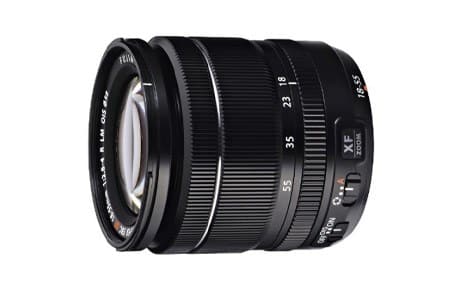
The Fujifilm 18-55mm f/2.8-4 R LM OIS is very similar in design to the 16-55mm f/2.8 but lacks several key features that help bring the price down. In our opinion, it’s much better for the money.
This lens does not have weather resistance so it needs to be protected in rough environmental conditions. Also the lens stops down to f/4 maximum at the telephoto end. This means you’ll only get bokeh and shallower depths of field at the wide angle end which may not be all that useful.
The focal length range is equivalent to 27-84mm full-frame lens which is an incredibly versatile wide angle-telephoto range. That makes it great for everything from portraits to architecture. Overall this is a great street photography lens. Plus at .68 lbs (10.88 oz) this lens weighs half as much as the 16-55mm f/2.8.
The built in OIS (Optical Image Stabilization) helps keep image blur from becoming an issue while shooting handheld. With up to four stops of IS, you can shoot at 1/500 and expect similar results as if you shot at 1/30.
Lastly the Nano GI (Gradient Index) coating of the glass alters the refractive index between the lens glass and the air. The result is less ghosting and flare from incidental lighting.
You can buy it at Amazon or see more reviews here.
Fujifilm XF 18-135mm f/3.5-5.6 R LM OIS WR
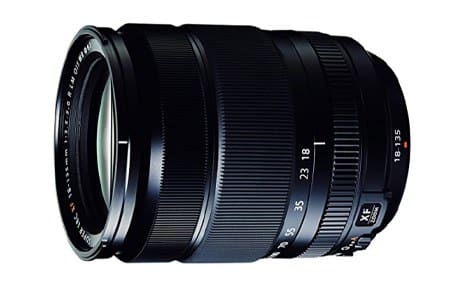
The Fujifilm XF 18-135mm f/3.5-5.6 R LM OIS WR is an extremely versatile lens meant to cover a wide variety of subjects. Everything from landscapes and architecture, to portraits and wildlife are all possible with this lens.
Using the APS-C sized sensors for the X-series cameras the focal range is equivalent to a versatile 27-206mm on a full-frame body. The aperture is not very fast, however, which is typical of zoom lenses in order to cut costs. f/3.5 won’t give a wafer thin depth of field no matter the focal length. But the trade off is incredible versatility in captures in all weather conditions.
Shooting handheld with this lens is a pleasure even at 135mm. The lens combines the Linear Motor (LM) design with optical image stabilization (OIS) elements to create powerful motion blur compensation. Five stops of image stabilization help keep photos sharp even shooting handheld in low light settings.
As a WR (weather resistant) lens the XF 18-135mm has 20 seals to prevent dust and moisture from penetrating the interior of the lens. The lens can even operate in temperatures as low as 14F (-10C) making this a great choice for nature photographers who won’t let snow and rain keep them from getting the best shots.
The glass of this lens is coated with a High Transmittance Electron Beam Coating (HT-EBC) to reduce ghosting, lens flare, and chromatic aberrations. Image sharpness and contrast remain optimized. Also the coating provides extra scratch protection.
You can buy it at Amazon or see more reviews here.
Fujifilm XF 55-200mm f/3.5-4.8 R LM OIS
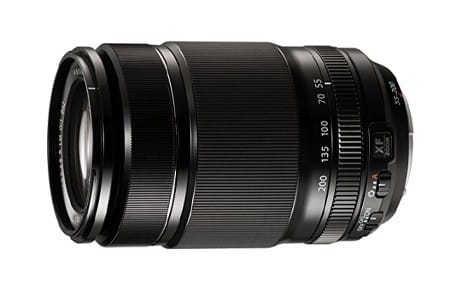
The Fujifilm XF 55-200mm f/2.5-4.8 R LM OIS is a fantastic portrait and wildlife lens with a huge reach.
On the X-series’s APS-C sensor this lens has a full-frame equivalent focal range of 84-305mm. With a 3.6 ft (1.1 m) minimum focusing distance, you need a bit of distance from the target to capture the best view possible.
The barrel has an aperture ring for precision aperture control with 1/3 stop increments. The linear motor (LM) autofocus motors allow the lens to focus within 0.28 seconds and ensure the lens remains quiet and stable during focusing.
The optical image stabilization (OIS) system provides up to four and a half stops of stabilization to make shooting handheld easier despite the long focal lengths of this lens. The glass also has a High Transmittance Electron Beam Coating (HT-EBC) to reduce ghosting, lens flare, and chromatic aberrations.
The 55-200mm f/3.5-4.8 is the toned down version of the 50-140mm f/2.8 lens. While the expanded focal range of the f/3.5 looks tempting the wider aperture of the latter lens is a tremendous advantage. The f/2.8 is also weather sealed for lovers of the outdoors. But for half the price of the f/2.8 the f/3.5 is still an excellent zoom lens.
You can buy it at Amazon or see more reviews here.
Best Fujifilm Prime Travel Lenses
If you want keep it simple and light, a prime lens is the way to go. There’s no zoom, but in return you get a much more compact lens with a bigger maximum aperture.
Fujifilm XF 23mm f/2 R WR
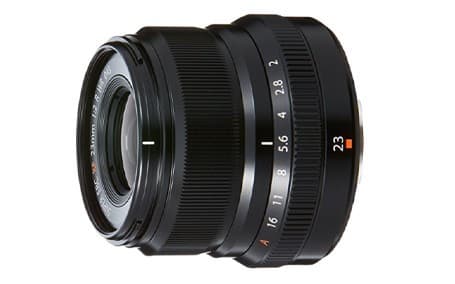
The Fujifim XF 23mm f/2 R WR is a rugged version of the 23mm f/1.4 R. At half the price, the f/2 R WR is a strong challenger. Although the aperture is not as wide f/2 is still a great aperture for portrait and event photography. It also allows for good performance in challenging lighting conditions.
The weather sealing of the f/2 R WR helps ensure the elements don’t penetrate, making it an excellent lens for nature and landscape photographers. This added protection allows normal operation down to 14 F (-10 C).
The 23mm view of this lens is a 35mm equivalent on a full-frame sensor. 35mm is closest to the view of the human eye, making the XF 23mm f/2 a more versatile outdoor lens for scenes such as portraits, streets, nature and food photography.
The glass of this lens does not have the layered High Transmittance Electron Beam Coating (HT-EBC) of the 23mm f/1.4 R. Nor does it have the Nano-GI layer of the 16mm f/1.4 WR. Overall the 23mm f/2 R WR is a weather sealed middle ground lens but has slightly less image sharpness and clarity compared to its higher priced siblings.
You can buy it at Amazon or see more reviews here.
Fujifilm XF 27mm f/2.8
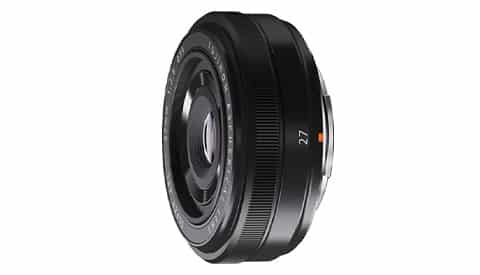
The Fujifilm XF 27mm f/2.8 is a pancake lens which means it has a compacted styling. The designs of these lenses can sometimes result in vignetting and poor image sharpness. However, the 27mm f/2.8 remains tack sharp throughout the frame.
Unlike other lenses, a pancake lens has no room for an adjustable aperture ring due to its smaller design. But at .17 lbs (2.75 oz) and a thickness of only 0.9 in., this lens is incredibly light. It keeps a camera pocket sized even with the lens attached.
The multi-layered High Transmittance Electron Beam Coating (HT-EBC) on the surface of the glass helps protect against scratching. It also helps prevent contrast and sharpness loss through scattering of incidental light.
The 27mm field of view is equivalent to 41mm on a full-frame sensor. The field of view is similar to that of a 35mm but gives a bit more intimacy. This makes the 27mm f/2.8 slightly more single subject oriented rather than landscapes but you can always move as needed to get a wider field of view.
While the aperture is not as wide as others the generalist focal length, price tag and pancake design make the 27mm f/2.8 a very attractive choice.
You can buy it at Amazon or see more reviews here.
Fujifilm XF 35mm f/2 R WR
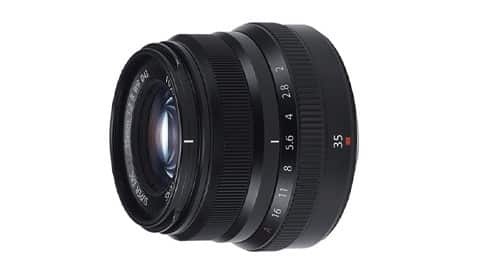
The Fujifilm XF 35mm f/2 R WR is suited for photographers who want a versatile focal length prime lens that can be used in all weather conditions.
Being a WR lens the 35mm f/2 is weather resistant, making it a great choice for nature photographers. Light rain and dust won’t penetrate any of the eight seals on the lens body. The lens will also operate normally in temperatures as low as 14F (-10C).
35mm is equivalent to a 50mm field of view using the APS-C sensors of the X-series cameras. And 50mm works very well for a wide variety of subjects, including portraits, nature, and event shots. It’s also the most recommended prime for traveling at Fujifilm’s blog.
f/2 is not as fast as f/1.4 but still allows in plenty of light for low light shoots. The depth of field will be shallow at this setting and will create excellent bokeh using nine aperture blades. This lens also has an inner auto focus system combined with a stepping motor for whisper quiet focusing and a response time as fast as 0.08 seconds.
The glass is very high quality and includes a Nano-GI (Gradient Index) coating. This layer changes the refractive index between the glass and surrounding air. In doing so ghosting and flares from incidental lighting are reduced or eliminated entirely.
You can buy it at Amazon or see more reviews here.
Fujifilm XF 50mm f/2 R WR
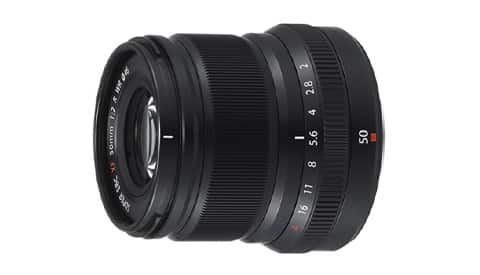
The Fujifilm XF 50mm f/2 R WR is a great lens if you want to photograph portraits and don’t want to be concerned with water or dust affecting their lens.
Using the APS-C sized sensors of the X-series cameras this lens is equivalent to a 76mm prime lens using a full-frame field of view. 76mm is squarely in portrait territory. The features of subjects won’t suffer from distortion and enough of the scene shows up without taking away from the main subject.
This lens also has enough reach to be useful for candid street photographers who want to capture a subject without being too obtrusive. Nature photographers will also find this focal length fairly useful, though shy subjects may require a bit more reach.
f/2 is a fast aperture but if you want an even shallower depth of field, you should look at the bigger and heavier XF f/1.2 R, which has a 56mm focal length The 16mm f1.4 R WR is also wonderful if you want weather sealing and don’t mind a wide angle field of view, but you will most likely find it too wide for travel unless you’re mostly interested in landscape.
The 50mm f/2 R WR is almost identical to the 35mm f/2 R WR. This lens is slightly more expensive as it’s 2 years newer. Instead of a Nano-GI layer, the 50mm f/2 uses a Super Electron Beam coating. Both approaches have the same effect: control over ghosting and flare for improved image quality.
You can buy it at Amazon or see more reviews here.
Fujifilm Lens Terms:
XF – Highest quality Fujifilm lenses for X-mount (X-T2, X-T1 and so on)
WR – Weather Resistant construction
R – The lens has a dedicated aperture ring
OIS – Optical Image Stabilization
LM – Linear Motor, allows faster and near silent focusing
Our Top 3 Fujifilm Travel Lenses:
Fujifilm XF 10-24mm f/4 R OIS
 Fujifilm XF 18-55mm f/2.8-4 R LM OIS
Fujifilm XF 18-55mm f/2.8-4 R LM OIS
Fujifilm XF 18-135mm f/3.5-5.6 R LM OIS WR
Fujifilm XF 23mm f/2 R WR
Fujifilm XF 27mm f/2.8
Fujifilm XF 35mm f/2 R WR
Last Updated on September 14, 2021 by Nick Voorhees
First and foremost, I’m a husband and father. Then professionally I’m photographer, designer, blogger, and Esty store owner. My homebase is near the stunning Wasatch mountains in Utah but I love traveling with my family as part of our homeschooling journey. I also love teaching and helping out others. My faith is one of the biggest aspects of my life and brings be a consistent joy that I haven’t found in anything else. My main blog is BestPhotographyGear.com and I strive to make photography simple for anyone looking to learn or find gear for their individual needs. By nature, I like to study, research, and analyze things and I use that help provide the best advice and reviews I can.
